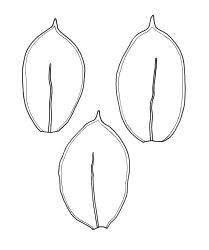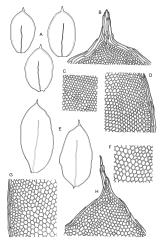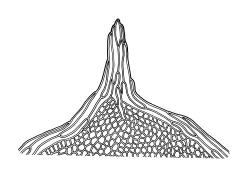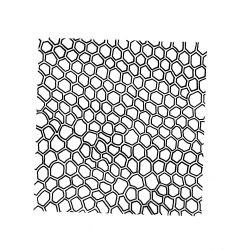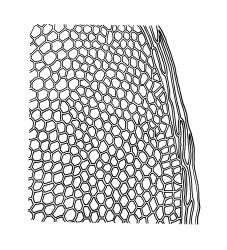Plants not or weakly iridescent when dry, forming rather compact mats. Stems weakly ascendant, weakly branched, to at least 10 mm. Shoots c. 3 mm wide. Leaves strongly crisped when dry, obscuring the complanate nature of the shoot, (0.8–)1.0–1.5(–1.8) × 0.6–0.8 mm, stoutly bordered, entire; upper laminal cells beyond costa firm-walled, ± hexagonal, 9–15(–20) × 9–12 µm, becoming larger (to 54 µm) and laxer toward insertion and adjacent to the costa; border stout, c. 15–30 µm wide at mid leaf. Costa unbranched or weakly spurred, extending ⅔–¾ the leaf length.
Dioicous. Perichaetial leaves ovate-acuminate, not or weakly bordered, ecostate, to c. 750 µm. Perigonia gemmiform, scattered on ♂ stems, with cuspidate, ecostate, and scarcely bordered bracts c. 600 µm long. Setae 3–6 mm; capsules c. 0.7–0.8 mm; annulus not seen; operculum long rostrate, c. 0.5–0.6 mm. Peristome and calyptra as per species. Spores 10–12 µm.
Wilson 1854, pl. 43, fig. 2 (as Hookeria crispula). Streimann’s (1999, fig. 1) illustration of D. crispulum is drawn in part from H. Streimann 52479 (HO 80106), a duplicate of which (CHR 504066) is referable to D. crispulum var. adnatum.
K; NI: N Auckland (Te Huka, Whangaruru North Head, Trounson Kauri Park, Kaukapakapa, Waipoua Forest, Waitakere Ranges) including offshore islands (LB, GB), S Auckland (Coromandel Peninsula), Gisborne (Waihau Bay, Opotiki).
Probably endemic. Sainsbury‘s (1955, p. 398) statement concerning the distribution of D. crispulum is difficult to interpret, but he seemed to consider this taxon to be restricted to northern portions of the North I., an interpretation in agreement with that given here.
Restricted to warm temperate forests; growing on moist shaded soil or weathered rock, often beneath canopies of Agathis australis or Beilschmiedia tarairi. Ranging from c. 20 m (Whangaruru North Head Scenic Reserve) to at least 300 m (Walker Bush Track in Waitakere Ranges) on the North I. The single Kermadec collection grew in pōhutukawa/nīkau forest at an elevation of 451 m.
Distichophyllum crispulum has been reported from mainland Australia by Scott & Stone (1976, p. 390) and by Streimann (1999), who recorded it to be widespread in extreme eastern Australia from the easternmost Victoria northward to the vicinity of Cooktown, Queensland. The few mainland Australia (and one Norfolk I.) specimens that I have seen named as D. crispulum, including three named by Streimann, are either better referred to the var. adnatum (q.v.) or are clearly D. rotundifolium. Scott & Stone (1976, p. 390) also recorded D. crispulum from Tasmania. However, Dalton et al. (1991) were unable to confirm its presence on that island and Streimann (1999) did not record it there. All the purported D. crispulum in HO has been referred to D. rotundifolium. The Archer collections (in BM) cited in Flora Tasmaniae by Wilson (1859) are likewise referable to D. rotundifolium. The occurrence of the variety crispulum outside of N.Z. is therefore considered doubtful.
Using the characters given in the key to species, all but a small fraction of N.Z. specimens can be confidently named to either this variety or to var. adnatum. I concur with Sainsbury that recognition at the varietal, rather than specific, rank is appropriate. The difficulty in distinguishing some material of D. crispulum var. crispulum from D. rotundifolium is discussed under the latter taxon.
Hookeria crispula was aptly compared, at the time of its original description, to the South American D. dicksonii (Hook. & Grev.) Mitt. (Mitten 1869). Distichophyllum dicksonii is a smaller plant with entire leaves generally <1 mm long with a much more delicate border and larger upper laminal cells than D. crispulum. A marked iridescence in D. dicksonii also serves to differentiate it from D. crispulum var. crispulum.



